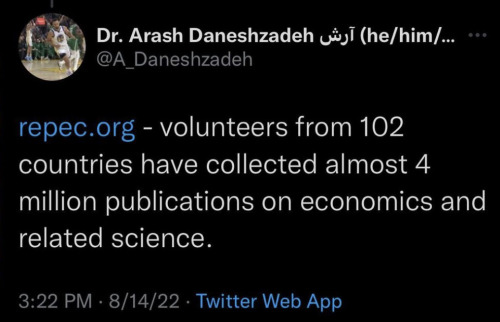A Dragon Decides To Become A Mercenary After Finding Out Humans Will Give You A Lot Of Gold In Exchange
A dragon decides to become a mercenary after finding out humans will give you a lot of gold in exchange for killing other humans.
More Posts from God-made-it and Others
Secret bunkers full of time machine repair equipment are placed throughout history by time travelers just in case someone gets stuck in the wrong time. You are tasked with manning one of these bunkers
Amen sister.
My mom felt that it was was very important for all of us to learn all the tasks for living for (at least) three reasons. 1. So we would could live on our own and not be pressed in to getting into a relationship because of life skills. (Go ahead and laugh but I have actually heard of many people having this problem) 2. When we do get married we would be prepared to overlap with our spouse. 3. So we would be prepared to run our married life if our spouse is sick of laid up or something (Mom often pointed out how in a story that one person would struggle because the skills were divided by gender [even funnier is when it was a different culture]).
They really went off with "Get married so you can divide all the important tasks of staying alive with another person."
They really tripped up with, "but we're going to assign all those tasks by gender instead of skill."
The Causal Chain And Why Your Story Needs It
The most obnoxious thing my writing teacher taught me every story needed, that I absolutely loathed studying in the moment and that only later, after months of resisting and fighting realized she was right, was something called the causal chain.
Simply put, the causal chain is the linked cause-and-effect that must logically connect every event, reaction, and beat that takes place in your story to the ones before and after.
The Causal Chain is exhausting to go through. It is infuriating when someone points out that an event or a character beat comes out of nowhere, unmoored from events around it.
It is profoundly necessary to learn and include because a cause-and-effect chain is what allows readers to follow your story logically which means they can start anticipating what happens next, which is what is required for a writer to be able to build suspense and cognitively engage the audience, to surprise them, and to not infuriate them with random coincidences that hurt or help the characters in order to clumsily advance the author's goals.
By all means, write your story as you want to write it in the first draft, and don't worry about this principle too much. This is an editing tool, not a first draft tool. But one of the first things you should do when retroactively begin preparing your story to be read by others is going step by step through each event and confirming that a previous event leads to it and that subsequent events are impacted by it on the page.
What are some chronic illnesses that can only occur in a fantasy setting?
I love this take
Since birth you could see a counter above people’s heads. It doesn’t count down to their death. It goes up and down randomly. You’re desperate to find out what it means.
"I'm sorry I flirted, I was trying to roast you."
- Elizabeth Bennet after Mr Darcy's first proposal
Space is a Dusty Place!

Butterfly Nebula
When you look at pictures of space, do you know what you’re actually seeing? A lot of the time the answer is dust!

HII region seen by Chandra X-ray Observatory
Clouds of dust drift through our galaxy. Telescopes can take pictures of these clouds when stars light them up. Who knew dust could be so beautiful? But it’s more than just pretty – we can learn a lot from it, too!

Stars like our Sun are born in dust clouds. Over time, leftover dust clumps together to help form planets. That makes it a little less dusty.

At certain times of the year, a band of sun-reflecting dust from the inner Solar System appears prominently just after sunset -- or just before sunrise -- and is called zodiacal light. Credit: Ruslan Merzlyakov/astrorms
But later, objects like comets and asteroids can create new dust by breaking up into tiny rocks. In our solar system, these rocky grains are called zodiacal dust. That’s because it’s mostly visible near the constellations of the zodiac. We can see the hazy glow it creates just after sunset or shortly before dawn sometimes, like in the picture above.

Around other stars, it’s called exozodiacal dust. Try saying that five times fast! It makes it hazy there too, so it can be hard to see distant planets.

Our Nancy Grace Roman Space Telescope will be really good at seeing how much of this dust is swirling around nearby stars. That will help future telescopes know the best places to look to find planets like Earth!
Roman will also see more distant objects. It will peer inside dust clouds where new stars are bursting into life. That will help our James Webb Space Telescope know where to look to find baby planets. Webb can zoom in for a more detailed look at these young worlds by seeing how they filter their host star’s light.

Roman will see huge patches of the sky – much bigger than our Hubble and Webb telescopes can see. These missions will team up to explore all kinds of cosmic mysteries!
Learn more about the exciting science Roman will investigate on Twitter and Facebook.
Make sure to follow us on Tumblr for your regular dose of space!


refseek.com

www.worldcat.org/

link.springer.com

http://bioline.org.br/

repec.org

science.gov

pdfdrive.com
One side effect of my research for this novel being steeped heavily in textile history is my swelling disgust with modern fabrics.
Firstly they're so thin? Like most things you see in Old Navy or even department stores might as well be tissue paper?? Even some branded sports t-shirts I've bought in recent years (that are supposed to be 'official apparel' and allegedly decent quality) are definitely not going to hold up more than a year or two without getting little holes from wear.
This side of even two hundred years ago fabrics were made to be used for YEARS, and that's with wearing them way more often because you only owned like three sets of clothes. They were thick and well made and most importantly made to LAST. And they were gorgeous?? Some of the weaves were so fine and the drape so buttery we still don't entirely know how these people managed to make them BY HAND. Not to mention intricate patterning and details that turned even some simple garments into freaking ART.
I know this is not news, the fast fashion phenomenon is well documented. Reading so much about the amazing fabrics we used to create and how we cherished and valued them, though, is making it hard not to mourn what we lost to mass production and capitalism. Not just the quality of the clothing and fabrics themselves, but the generations of knowledge and techniques that are just gone. It makes me what to cry.
I need to get a sewing machine.
Lol






It’s always exciting to add to the manual.
-
 wip--work-in-progress liked this · 2 months ago
wip--work-in-progress liked this · 2 months ago -
 puppeteersailor liked this · 7 months ago
puppeteersailor liked this · 7 months ago -
 eyes-apple liked this · 7 months ago
eyes-apple liked this · 7 months ago -
 melmoland liked this · 8 months ago
melmoland liked this · 8 months ago -
 whatshappyfeellike liked this · 11 months ago
whatshappyfeellike liked this · 11 months ago -
 mirbisduschoen reblogged this · 1 year ago
mirbisduschoen reblogged this · 1 year ago -
 mirbisduschoen liked this · 1 year ago
mirbisduschoen liked this · 1 year ago -
 insignificant-artist reblogged this · 1 year ago
insignificant-artist reblogged this · 1 year ago -
 rayis-blog liked this · 1 year ago
rayis-blog liked this · 1 year ago -
 schlockamorph liked this · 1 year ago
schlockamorph liked this · 1 year ago -
 static-kills liked this · 1 year ago
static-kills liked this · 1 year ago -
 gillth3blur3 liked this · 1 year ago
gillth3blur3 liked this · 1 year ago -
 sakurarosebud liked this · 1 year ago
sakurarosebud liked this · 1 year ago -
 eren-is-way-better-than-levi liked this · 1 year ago
eren-is-way-better-than-levi liked this · 1 year ago -
 insignificant-artist liked this · 1 year ago
insignificant-artist liked this · 1 year ago -
 nyanyadninjago liked this · 1 year ago
nyanyadninjago liked this · 1 year ago -
 claycreations liked this · 1 year ago
claycreations liked this · 1 year ago -
 eldritchcat0 liked this · 1 year ago
eldritchcat0 liked this · 1 year ago -
 maldragon-triplet1 liked this · 1 year ago
maldragon-triplet1 liked this · 1 year ago -
 1-randomized liked this · 1 year ago
1-randomized liked this · 1 year ago -
 starcrystal717 liked this · 1 year ago
starcrystal717 liked this · 1 year ago -
 marbarinthebar liked this · 1 year ago
marbarinthebar liked this · 1 year ago -
 unknown-gerenuk liked this · 1 year ago
unknown-gerenuk liked this · 1 year ago -
 the-oracle-at-delphinitely-not liked this · 1 year ago
the-oracle-at-delphinitely-not liked this · 1 year ago -
 lesbian-and-not-actually-mothman liked this · 1 year ago
lesbian-and-not-actually-mothman liked this · 1 year ago -
 surknightp liked this · 1 year ago
surknightp liked this · 1 year ago -
 percy-jacksonfan liked this · 1 year ago
percy-jacksonfan liked this · 1 year ago -
 pineweedle liked this · 1 year ago
pineweedle liked this · 1 year ago -
 hallodoesstuff liked this · 1 year ago
hallodoesstuff liked this · 1 year ago -
 mysuperdupersecretsideblog liked this · 1 year ago
mysuperdupersecretsideblog liked this · 1 year ago -
 ronaldweasleyhowdareyou liked this · 1 year ago
ronaldweasleyhowdareyou liked this · 1 year ago -
 idiot-dummy liked this · 1 year ago
idiot-dummy liked this · 1 year ago -
 themandolillian liked this · 1 year ago
themandolillian liked this · 1 year ago -
 vikzy1028 liked this · 1 year ago
vikzy1028 liked this · 1 year ago -
 anrentadashi liked this · 1 year ago
anrentadashi liked this · 1 year ago -
 gay-raccoons-eating-pinecones liked this · 1 year ago
gay-raccoons-eating-pinecones liked this · 1 year ago -
 rubyredtofrug liked this · 1 year ago
rubyredtofrug liked this · 1 year ago -
 an-obsevable-cracker liked this · 1 year ago
an-obsevable-cracker liked this · 1 year ago -
 beewhimsical liked this · 2 years ago
beewhimsical liked this · 2 years ago -
 leila-kjolak-fate reblogged this · 2 years ago
leila-kjolak-fate reblogged this · 2 years ago -
 leila-kjolak-fate liked this · 2 years ago
leila-kjolak-fate liked this · 2 years ago -
 plotbunnypettingzoo liked this · 2 years ago
plotbunnypettingzoo liked this · 2 years ago
